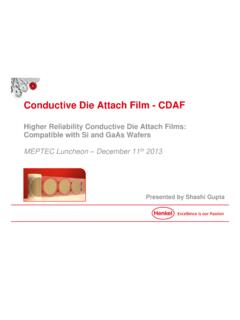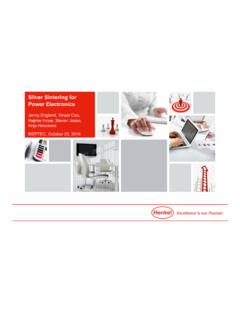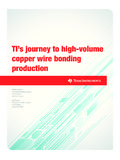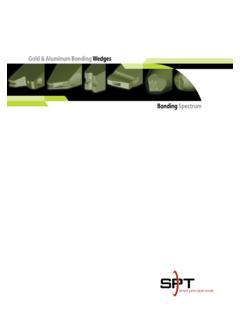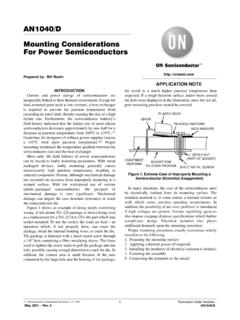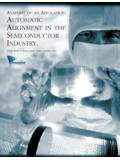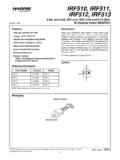Transcription of MEPTEC 2017 SEMICONDUCTOR PACKAGING …
1 SPRING 2011 MEPTEC Report THIS ISSUE18 Advanced packag-ing industry s first movers, competitive advantage, and dis-ruptive Heterogeneous Integration Roadmap has accomplished a great deal in the first 67th ECTC lived up to its reputation as the premium international event of the microelec-tronics PACKAGING Quarterly Publication of the Microelectronics PACKAGING & Test Engineering CouncilVolume 21, Number 3 FALL 201730Do MEMS work for you? Yes, of course. You use them every day when you use your phone, drive your car, and look at your TECHNOLOGY BRIEFSIBM Zurich researchers have developed a tiny redox flow battery. Future computer chip stacks, in which individual chips are stacked to save space and energy, could be supplied with electrical power and cooled at the same time with these integrated flow batteries. page 23++Where is the SEMICONDUCTOR Manufacturing Sweet Spot? page 12 SEMICONDUCTOR PACKAGINGSYMPOSIUMHETEROGENOUS INTEGRATION THE ROAD TO IMPLEMENTATION Thursday, November 30, 2017 - San Jose, CA page 11 MEPTEC 2017 HETEROGENOUS INTEGRATION THE ROAD TO IMPLEMENTATION Thursday, November 30, 2017 - San Jose, CA page 11 Where is the SEMICONDUCTOR Manufacturing Sweet Spot?
2 Page 12A Quarterly Publication of The Microelectronics PACKAGING & Test Engineering CouncilVolume 21, Number 3 FALL 2017 MEPTEC Report Vol. 21, No. 3. Published quarterly by MEPCOM LLC, 315 Savannah River Dr., Summerville, SC 29485. Copyright 2017 by MEPCOM LLC. All rights reserved. Materials may not be reproduced in whole or in part without written permission. MEPTEC Report is sent without charge to members of MEPTEC . For non-members, yearly subscriptions are available for $75 in the United States, $80US in Canada and Mexico, and $95US elsewhere. For advertising rates and information contact Gina Edwards at 408-858-5493, Fax Toll Free THE COVERThe MEPTEC 2017 SEMICONDUCTOR PACKAGING Symposium - Heterogenous Integra-tion the Road to Implementation, will be held on Thursday, November 30, 2017 at the SEMI Global Headquarters in Milpitas, CA. This event will explore three issues central to the successful execution of heterogeneous integrated pack-ages: Can the PACKAGING community establish a real design for heterogeneous integration ecosystem?
3 Should we rethink the reliability standards for these het-erogeneous integrated SIP packages? What are the best test strategies for these heterogeneous integrations, or at least what are the guiding principles?12 ANALYSIS Where is the SEMICONDUCTOR manufacturing sweet spot? Two recent Semico Research Corp. studies pro-vide the information to not only determine the overall sweet spot but to dig even further to find which products and technologies are the driving forces behind the growth or VOGELEI SEMICO RESEARCH CORPORATION18 PACKAGING What happens to Intel s competitive ad-vantage when Intel is no longer first mover for advanced process nodes in commercial SEMICONDUCTOR device fabrication? Or, conversely, how much of Intel s present success is a result of it having been the first mover in SEMICONDUCTOR fabrication process and PACKAGING technology over the long period of time that it has?PAUL WERBANETH INTEVAC, TECHNOLOGY The Heterogeneous Integration Road-map serves our profession, industry, academia, government and research institutes to meet the challenges of this new world by stimulating pre-competitive collaboration.
4 This collaboration enables resolution of difficult challenges before they become roadblocks to continuation of the rate of progress. WILMER R. BOTTOMS, MILLENNIUM TEST SOLUTIONS AND HIR CO-CHAIR23 TECH BRIEFS The State-of-the-Art Technology Briefs contains articles from the Binghamton University S3IP Flashes. Binghamton University currently has research thrusts in healthcare/medical electronics; PACKAGING ; power elec-tronics; cybersecure hw/sw systems; photonics; MEMS; and next generation networks, computers and GAMAL RAFAI-AHMEDXILINXThe MEPTEC Report is a Publication of the Microelectronics PACKAGING & Test Engineering Council 315 Savannah River Dr., Summerville, SC 29485 Tel: (650) 714-1570 Email: MEPCOM LLCE ditor Bette CooperArt Director/Designer Gary BrownSales Manager Gina EdwardsMEPTEC Advisory BoardBoard MembersIvor Barber AMDJoel Camarda SemiOpsJeff Demmin Booz Allen HamiltonDouglass Dixon Henkel CorporationNick Leonardi SMART MicrosystemsPhil Marcoux PPM AssociatesGamal Refai-Ahmed XilinxRich Rice ASE (US) Shen Altera Scott Sikorski STATS ChipPACJim Walker WLP ConceptsSpecial AdvisorsRon Jones N-Able Group InternationalMary Olsson Gary Smith EDAH onorary AdvisorsSeth Alavi SunsilGary CatlinRob ColeSkip FehrAnna Gualtieri Elle TechnologyMarc Papageorge ICINTEKIn MemoriamBance HomContributorsMatt Apanius SMART Microsystems Ltd.
5 Bill Bottoms, Third Millennium Test William Boyce SMART Microsystems Choi Henkel Electronic Materials LLCDoug Dixon Henkel Electronic Materials LLCIra Feldman Feldman Engineering Corp. Ron Jones N-Able Group InternationalDr. Gamal Rafai-Ahmed Xilinx Rick Vogelei Semico Research Corporation Paul Werbaneth Intevac, Inc. DEPARTMENTS 7 Event Follow-Up 8 Coupling & Crosstalk10 Industry Insights 20 SMART Microsystems News26 Henkel News 30 Opinion 12 MEPTEC REPORT FALL Chart 2 developed from data in the wafer demand study, shows wafer demand by technology node. The first category, greater than or equal to 800nm, was chosen because it repre-sents most manufacturing in 150mm or smaller fabs. The second category, 500nm through 130nm, was chosen because it represents most manufacturing in 200mm fabs. The CAGR for 2016 through 2021 for this category is Most 300mm fabs are at technology nodes beyond 100nm, the third category. The CAGR for 2016 through 2021 for this category is So, where is the SEMICONDUCTOR manufacturing sweet spot?
6 It depends. The sweet spot for new fabs is 300mm. The sweet spot for wafer demand is 300mm wafers. However, there continues to be significant demand for 200mm capac-ity for MEMS and Sensors, microcon-trollers, analog, etc. A variety of factors are impacting the sweet spot. Material costs are increasing, specifically silicon wafers. If the price of 300mm wafers increases faster than 200mm wafers, the shift to 300mm production will be slower than expected. The challenge for 200mm wafers is the concern over availability and cost of 200mm equipment. The continued operation of 40+ years old 200mm fabs is becoming more challenging as equipment and maintenance become scarcer and more expensive. Will the cost associated with 300mm production finally push 450mm wafer development forward? Wherever your sweet spot is, Semico s fab database and wafer demand studies have the data to help you find it. These studies are: Semico Fab Database: Update Summary, First Half 2017 Semico Wafer Demand: Q2 2017 Highlights Contact Rick Vogelei at for more information.
7 FALL 2017 MEPTEC REPORT IS THE SEMICONDUCTOR manufacturing sweet spot? Two recent Semico Research Corp. studies provide the information to not only determine the overall sweet spot but to dig even further to find which products and technologies are the driving forces behind the growth or decline. Chart 1 was developed from data in the fab database study. It shows the number of fabs operating and planned by wafer size. Surprisingly, there are still almost 300 fabs operating at 150mm or smaller. Many manufacture trailing edge devices, especially discretes, while others manu-facture relatively new devices, including analog, power, MEMS and LED devices. These semiconductors are not leading-edge devices, but they are essential to many electronics industry end-use prod-ucts. The die size for many is quite small, and they do not scale well to smaller geometries. Many may continue to be manufactured in 150mm fabs for the immediate future. Others will undoubtedly migrate to 200mm fabs.
8 In 2017 , there are over 190 fabs manufacturing devices on 200mm wafers. Many are producing MOS Logic semi-conductors, but there is a sprinkling of 200mm fabs producing a wide variety of other SEMICONDUCTOR product types includ-ing analog semiconductors , MEMS devic-es, power semiconductors , and SRAM. Ten more 200mm fabs are planned, with one under construction. There are more than 150 300mm fabs operating or under construction in 2017 . These fabs are focused on high-volume devices manufactured at leading-edge technology nodes, including MPUs, DRAM, and NAND Flash. Following the usual pattern, many SEMICONDUCTOR product types will migrate from 200mm to 300mm fabs. Almost 30 additional 300mm fabs are planned. ANALYSIS Rick Vogelei, Business Development Semico Research CorporationWhere is the SEMICONDUCTOR Manufacturing Sweet Spot? As the premier event in the SEMICONDUCTOR PACKAGING industry, ECTC addresses new developments, trends and applications for fan-out & fan-in packages, 3D & integration, TSV, WLP, flip-chip, photonics, LEDs, materials and other integrated systems PACKAGING submissions and Professional Development Course proposals for the 68th ECTC are due by October 9, 2017 .
9 To submit, visit: Sponsors:Call for Papers Opens August 8!We welcome previously unpublished, non-commercial abstracts in areas including, but not limited to:Advanced PackagingApplied ReliabilityAssembly & Manufacturing TechnologyEmerging TechnologiesHigh-Speed, Wireless & ComponentsInterconnectionsMaterials & ProcessingOptoelectronics Thermal/Mechanical Simulation & CharacterizationChart 1. Number of Fabs, Operating and Planned, by Wafer SizeChart 2. Wafer Demand by Technology Node Source: Semico Research JOSE, CAMEPTEC 2017 SEMICONDUCTOR INTEGRATION:THE ROAD TO IMPLEMENTATIONYour Microelectronic Package Assembly Solution for MEMS Sensorsthe moisture will boil off in the form of H2 and O2 gas creating gas bubbles that become trapped in the adhesive. Implementing a strategy for develop-ing a die attach method for a new MEMS product is critical in the early product development and design phase. Adhesive die attach contains numerous properties that can affect both the product function and the manufacturing process.
10 There are so many choices out there in elastomeric adhesive sealants. Each adhesive has its own set of advantages and drawbacks. There are plenty of intended and unin-tended consequences to all of them. It is important to consider the choices care-fully and thoughtfully as early as possible in the design process. This is the best way to avoid common pitfalls and ensure the development of a successful die attach method. William Boyce is the Engineering Manager at SMART Microsystems. He is detail-oriented and is a hands-on engineering leader with a wide range of diverse skills from his back-ground in automotive sensing. He has served in senior engineering roles over the last 19 years with accomplishments that include manufactured automotive sensors. He also led new product development teams that created over $25 million in new revenue per year. He is certified in EIT and Six Sigma Green Belt and is an industry recognized expert in Al wire bonding. Additionally, he designed and led the metrology lab and machine shop at Sensata.

